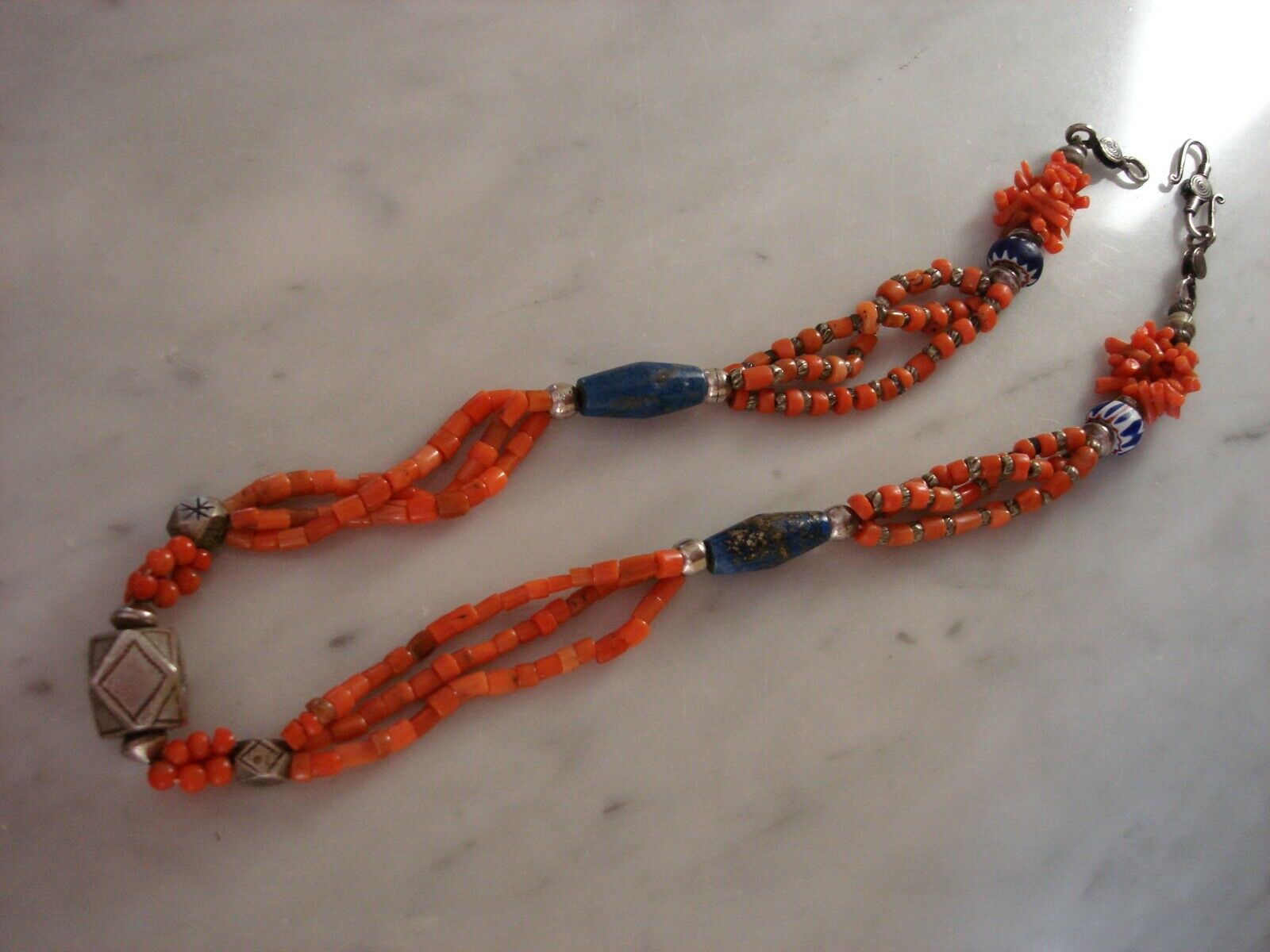-40%
Berber Enameled Kabyle Coral, millefiori, chevron, Turquoise Rolo Chain Necklace
$ 166.32
- Description
- Size Guide
Description
Berber Enameled Kabyle with coral & millefiori, chevron, Turquoise and carnelian gemstone charms on a silver hammered link chain Moroccan Tuareg handmade necklace.Mailed via usps 3 day first class mail.
Berber Enameled Kabyle coral with millefiori, chevron, Turquoise & carnelian gemstone charms on a silver link hammered chain Moroccan Tuareg handmade necklace.
Beautiful handmade Berber necklace with old orange coral beads, millefiori ancient beads, blue 6 layers chevron beads, turquoise, carnelian gemstone and antique silver beads with a vintage enameled Kabyle coral pendant with intricate green and orange glass enamel details with a red Coral branch embedded in the center.
The Kabyle Berber pendant is from Southern Morocco.
It measures approximately just over 1 3/8”” (3,6 cm) long and approximately 5/8” (1,6 cm) in width. The pendant feature a 3D bead shape, wirework and cobalt blue, golden yellow, and mint green enamel with a genuine coral bead cabochon on the bottom.
The Kabyle with coral pendant pair weights over 9 grams.
There are:
10 ancient millefiori charms.
2 old coral charms.
6 blue chevron 6 layers beads.
2 ancient carnelian beads.
4 old turquoise charms.
The extension chain has a small ancient carnelian & turquoise accent small beads.
This is a an antique silver textured belcher Rolo hammered chain 8mm x 5mm links. The chain is made of a brass base with an antique silver electroplating and clear coating. It’s lead, nickel and cadmium free.
The length of the chain is 24” plus an extension oval antique chain of 3.5”
This can be adjusted up to 27.5” and down to any size even as a choker.
There is a large old hook clasp closure.
This is a unique and special find.
Beautiful ethnic silver Berber Beni Yenni charm from Morocco. Almost all the silver jewelry from the kabyls are made with silver and enameling since over 800 years.
The enameling and smith work are very nicely done, the coral is high quality. Kabyle use the yellow, orange,green and blue colors in enamel.
The Kabyle people (Kabyle: Izwawen or Iqbayliyen, iqβæjlijən) are a Berber ethnic group indigenous to Kabylia in the north of Morocco and Algeria, spread across the Atlas Mountains, one hundred miles east of Algiers. They represent the largest Berber-speaking population of Algeria and the second largest in North Africa.
Chevron beads are special glass beads; the first specimens of this type were created by glass bead makers in Venice and Murano, Italy. They may also be referred to as rosetta, or star beads. The term rosetta first appeared in the inventory of the Barovier Glass works in Murano, in 1496, in context with beads as well as with other glass objects.
Venetian chevron beads are drawn beads, made from glass canes, which are shaped using specifically constructed star moulds. The first chevron beads were made towards the end of the 15th century, consisting of 7 layers of alternating colours. They usually have 6 facets. Unlike their later counterparts, they were not always made with the standard 12-point star mould. By the beginning of the 20th century, 4 and 6-layer chevron beads appear on various sample cards. According to records kept at the Societa Veneziana Conterie of Murano, they stopped making chevron canes during the 1950s. Chevron beads are still being made in Venice today, albeit in very small quantities.
Venetian glass millefiori beads have complex patterns that reflect the multi-step process of construction.
Designs are endless, and by going through the process is polymer clay instead of molten glass, more people can understand and appreciate them.
Native American tribes traded pelts and other objects for these beads and for seed beads. They saw the advantage of getting many colors of hard, glass beads without having to shape and drill them themselves. This trading eventually caused the waning of the use of porcupine quills and bone and shell beads. It also lead to an evolution in beading patterns and techniques, influenced by styles in the larger culture.
Millefiori Literally meaning a thousand flowers. Is one of the oldest and most well known techniques still in use in Murano. It is used to describe small mosaic cross sections of glass. The process involves stretching and shaping regular arrangements of multicoloured rods of glass. Normally the colours are added and a shape is created before the molten glass is stretched into a long thin cane. The cane can then be cut to size for use as beads or placed on a gather of molten glass (pea) for inclusion into murrina paperweights or blown vases.
Coral symbolizes life and blood force energy. Dark red coral is used for heating and stimulating the bloodstream. Pink shades restore harmony to the heart. It is used as an aid to depression, lethargy or deficient nutrition.
Locations where coral can be found include the Mediterranean Sea, off the coast of Australia, the South Pacific, the waters of Japan, and Africa.



















